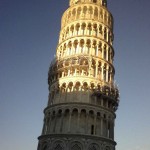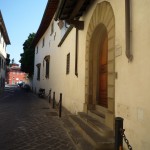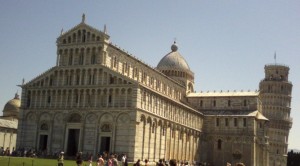|
|
By Joselle, on October 1st, 2009 Now we can identify the number the brain is identifying!
An article in Science News reports on how neuroscientists are able to determine the quantity of dots a person is looking at by looking at their brain activity patterns using an MRI. The study also revealed that the patterns that correspond to some number of dots, and the ones that correspond to the same number represented by a digit, were related but not the same. Computer analyses used to evaluate the patterns showed their relationship.
An interesting detail of the study’s findings was that an individual’s signature pattern for the digits could be used to determine the number of dots that person saw, but their signature pattern for the dots could not be used to determine what digit they had viewed. If the source of the digit pattern is the dot pattern, it would be easier to trace back to the originating dot pattern than it would to predict a digit pattern’s variation from that dot pattern. The researchers suggested that this was evidence that the brain’s action with respect to the non-symbolic quantities is, in some way, stronger. The patterns in brain activity when dots are viewed are more distinct and invariant.
Stanislas Dehaene is well known for his work on the neurological foundations of number and arithmetic and he is one of the authors of the paper in Current Biology on which this article is based. He has also found that non-symbolic quantities have a spatial aspect where larger numbers are associated with movement to the right and smaller ones with movement to the left. All of this suggests to me that our symbolic representations in mathematics are tied tightly to things the brain is already wired to do, albeit mathematics may be making significantly different use of it.
By Joselle, on August 26th, 2009
My introduction to Semir Zeki came in 1992 with a special issue of Scientific American called Mind And Brain. I still have the magazine with the lines I highlighted. I was excited when I read it. Something new was happening. Here are some of the passages I marked:
“The past two decades have brought neurologists many marvelous discoveries about the visual brain. Moreover, they have led to a powerful conceptual change in our view of what the visual brain does…. It is no longer possible to divide the process of seeing from that of understanding as neurologists once imagined, nor is it possible to separate the acquisition of visual knowledge from consciousness.” (Italics are mine)
Zeki concludes that, when seeing and understanding are viewed as one process, “our inquiry into the visual brain takes us into the very heart of humanity’s inquiry into its own nature.”
Since then, Zeki has written extensively, in books and papers, on how a neurobiological understanding of vision contributes to our understanding of artistic creativity. In so doing he pulls the curtain back and gives us a new way to self-reflect. Much of what he writes has impacted how I think about the emergence of mathematics. He convincingly argues that the visual arts can be seen as an extension of the brain’s visual processes and this helps me imagine mathematics as an extension (or at least a reflection) of neurological processes designed to manage perception and thought.
In an essay on artistic creativity and its relationship to visual processes, (Science Magazine, 2001), he ventures even further. Our brain, he explains, is the most variable, (in the Darwinian sense) and therefore the fastest evolving organ we have. While we don’t know the source of its variability, all manner of creative work is an expression of it. Zeki speculates that this variation is also the source of problematic deviant behavior. He believes that neurological studies of art and aesthetics (which he calls neuroesthetics) can help us understand what determines variability in general. Such studies would shed light on the common neural ground that makes it possible for us to appreciate a work of art. I would not be surprised if they also told us something about how we come to recognize the beauty of an equation.
He wrote chapter 2 of the book Neurology of the Arts, edited by F. Clifford Rose. The title of the chapter is Neural Concept Formation and Art: Dante, Michelangelo, Wagner. In it he focuses on the work of three particular figures in our history. But it also contains a good outline of how Zeki ties creative work to biological processes. He explains that abstraction is an essential characteristic “imposed upon the brain by one of its chief functions, namely the acquisition of knowledge.” Looking for the essence of things by using abstraction is what the brain is built to do. This looking for the essence, he argues, is what creative work is about.
How does the brain abstract? This is only partially known and Zeki gives us some examples. There are specialized brain cells that respond preferentially to straight lines at a particular angle. About a particular one of these he says, “The cell, in brief, abstracts for verticality, without being concerned about what is vertical” There are cells that synthesize multiple views of an object into a ‘view-invariant’ image. And there are also cells specialized to respond to particular colors or to motion in a particular direction. These are some of the attributes of retinal impressions that get sent to specialized regions in the brain and are used to construct what we see.
In both pieces, he explains that in its search for generalities, the brain inevitably creates the ideal from the particulars. Once formed, the ideal cannot be found in the world of particulars. This dissatisfaction with all particulars, or this frustration with the material that can never contain the ideal, is what Zeki believes caused Michelangelo to leave work unfinished. The book chapter more fully explores the impact of ideals on our experience, even with regard to love.
It’s hard to talk about ideals without Plato coming to mind. And there are many references to Plato in Zeki’s chapter. But neurobiologists seem to think that Plato didn’t quite have it right. For Plato, the ideal had an independent existence. For neurobiologists, it is an inevitable consequence of the brain’s working on the particulars. What I find striking is that, for both, the particulars are subordinated to the ideal. And Plato’s reverence for the ideals may have been born of an intuitive sense that they are the source of all knowledge, the fundamentally necessary ingredient, outside of our awareness, needed to shape the acquisition of knowledge.
By Joselle, on July 20th, 2009  Our family lived in France for the last six months and at the end of that time we had the chance to visit family in Florence. Since we drove to Florence we could stop at Pisa along the way. I found Galileo all around me. Our family lived in France for the last six months and at the end of that time we had the chance to visit family in Florence. Since we drove to Florence we could stop at Pisa along the way. I found Galileo all around me.
Dava Sobel’s book, Galileo’s Daughter, once drew me in and brought new life to the story of the physicist who was right and the Church that condemned him. Galileo had a daughter who loved him, wrote to him after his arrest, and she was a nun. The book makes us privy to this very human, albeit extraordinary, story. And it locates his home while under house arrest in Florence not far from the convent. We got the address, set out to find it and we did. When you visit such places, you try to get as close as you can to the lives you can’t touch, or the time outside your reach – to see something of the story’s three-dimensional reality.
 IL Gioiello of Galileo Galileo’s life in these cities is even more highlighted at the moment because August marks the 400th anniversary of his first telescope observations. We mostly imagine him as a physicist, but it was mathematics that captured his attention and was his profession. His affinity for mathematics is likely some consequence of the way he was poised to see. He is quoted as having said, “Where the senses fail us, reason must step in.” When we can’t see our way through something, we can shift our attention inward and reason our way through it. Reason builds on what the senses perceive, by opening a path and directing us when we can’t just watch where we’re going.
Looking closely at the abstract, this experimentalist had an insight about the notion of infinitely many things that foreshadowed work to come some 250 years later. In his book Two New Sciences, a conversation between Simplicio and Salviati (the Galileo character) outlines what is now called Galileo’s paradox – that there are the same number of perfect squares as there are whole numbers despite the fact that not every whole number is a perfect square. When Salviati describes the situation to Simplicio, he hints at the notion of one-to-one correspondence which will be invoked for the first time in 1874 by Georg Cantor. Salviati concludes that the attributes equal, greater or less do not apply to the infinite. When presented with lines of different lengths, Salviati tells us that it cannot be said that one line has more or less points than the other but simply that they both have an infinite number of them.
I imagine Galileo breathing in the fresh air of the Renaissance and breathing out ideas of the future. His role in our history seems an inevitable consequence of his nature, of the way he watched and reasoned. And he lived in a time when Western Europe may have been looking inward instead of just outward, across mysterious seas, to extend their reach or to move their horizon.
Galileo used what artists then understood about perspective to confirm that the spots he saw on the sun were, in fact, spots and not, as had been argued, other planetary spheres in front of the sun. He could see that their shape changed when viewed from different angles because they became foreshortened in precisely the way the mathematics of perspective required. And the word perspective is from the Latin perspicere, to see clearly.
 Galileo’s work is his perception of the world, very directly and it makes sense that we often use the telescope, the mechanical extension of sight, to symbolize his effectiveness. The sense that he was a vital individual, who was just looking, is captured in the legend that his thoughts on pendulum motion began during a service in the Pisa Cathedral. A swinging lamp caught his attention and he timed its swings with the beat of his pulse. His body was his clock. Galileo’s work is his perception of the world, very directly and it makes sense that we often use the telescope, the mechanical extension of sight, to symbolize his effectiveness. The sense that he was a vital individual, who was just looking, is captured in the legend that his thoughts on pendulum motion began during a service in the Pisa Cathedral. A swinging lamp caught his attention and he timed its swings with the beat of his pulse. His body was his clock.
A good look at Galileo renders a very human, natural view of science and mathematics. And I think he says it best with this: “In my opinion, nothing occurs contrary to nature except the impossible, and that never occurs.”
By Joselle, on June 20th, 2009
I hope to use this blog to find new things to see about mathematics. And this might even have some effect on how we see ourselves. I want to start with something Henri Poincare said. Poincare was an intellectual heavyweight, a mathematician, theoretical physicist, and philosopher. He was the last person to be able to know all of the mathematics that existed in his lifetime. And he made some nice remarks about mathematics and science, a bit unusual in their use of nature images. I’ve chosen to begin with this one because it led me to thoughts that contribute to this blog’s perspective:
“Though the source be obscure, still the stream flows on.”
There are no easy answers to questions about what mathematics is or where it’s coming from. But it may be that its source is obscure because we’re so close to it or, more to the point, because we’re embedded in it. Looking for it would be like looking for the source of all that we see when we open our eyes, which is very close to trying to find the source of our awareness.
I have come to think of mathematics as akin to vision. For us, seeing begins when light hits all of the material around us and makes some impression on the retina, which is built precisely to receive it. The brain then needs to piece bits of stimuli together, like movement, color, and form. Some visual theorists will go so far as to say that the brain invents the image we see. It searches out the essence of things so that, for instance, no matter how a speaker might be moving his hands in gesture, a hand is a hand is a hand. So vision has no single source. The source of what we see is, all at once, the light, the material it hits, and eye and brain tissue.
In mathematics, some of what the mind is piecing together may be the things we’ve seen, the ways we’ve reasoned, our experiences of time and distance, and pure products of our imagination. We take the contour of things we see, like the sun and the moon, and in our memory and imagination we find the circle. From two trees, two fingers, and two dogs…we form quantity and the number two. Some fundamental aspect of reason builds ‘if this then not that’ statements.
Perhaps mathematics inherited from vision the purpose of finding the essence of things. But it defines essence or equivalence and exploits it, creating extraordinary generalizations. Although it can be completely removed from the physical world, mathematics is somehow stretching what the body is made to do. And the brain keeps building structure, interlocking different parts of our experience and our thought, and finding things like analytic geometry or the derivative.
Poincare was an intuitionist meaning that he believed mathematics was grounded in intuition rather than logic. And he must be right. Logic just wouldn’t be enough. Why nature provides us the abilities that our mathematics reflects is the real mystery. Just like the question, why it has provided us eyes.
|
|

 Our family lived in France for the last six months and at the end of that time we had the chance to visit family in Florence. Since we drove to Florence we could stop at Pisa along the way. I found Galileo all around me.
Our family lived in France for the last six months and at the end of that time we had the chance to visit family in Florence. Since we drove to Florence we could stop at Pisa along the way. I found Galileo all around me.
 Galileo’s work is his perception of the world, very directly and it makes sense that we often use the telescope, the mechanical extension of sight, to symbolize his effectiveness. The sense that he was a vital individual, who was just looking, is captured in the legend that his thoughts on pendulum motion began during a service in the Pisa Cathedral. A swinging lamp caught his attention and he timed its swings with the beat of his pulse. His body was his clock.
Galileo’s work is his perception of the world, very directly and it makes sense that we often use the telescope, the mechanical extension of sight, to symbolize his effectiveness. The sense that he was a vital individual, who was just looking, is captured in the legend that his thoughts on pendulum motion began during a service in the Pisa Cathedral. A swinging lamp caught his attention and he timed its swings with the beat of his pulse. His body was his clock.
Recent Comments